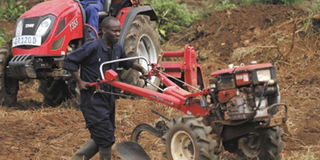Agricultural credit facility writes off Shs9.4 billion

Necessary support. Government continues to seek agricultural mechanisation through ensuring that farmers are provided with necessary support. FILE PHOTO
Fifteen loans valued at Shs9.4b financed under the Agricultural Credit Facility (ACF) were due for write off as at March 31, 2019.
The facility indicated in the 2019 agriculture finance year book published by Economic Policy Research Centre that about 2.8 per cent of its total loan books was due for write off.
“Fifteen (15) loans were due for write-off as at March 31, 2019. These accounted for Shs9.48b or 2.86 per cent of the total [facility] loan portfolio,” the report reads in part.
One of the 15 loans was acquired by a Sacco, which had rallied up about Shs18m.
Loan write off is when a bank removes a loan from its balance sheet when a debtor fails to pay after considerable amount of time.
No requisite instruments
According to Ms Rosette Bamwine, the head credit and marketing, ACF under Bank of Uganda, the facility was established without the requisite statutory instrument that would allow it, as a government project to write off loans.
“Government’s auditor general procedures do not adequately cater for periodic loan write off. Consequently, government’s failure and delays in settling participating financial institutions’ (PFIs) claims for loan losses have discouraged some from participating,” she noted in the report.
The ACF (and other credit guarantee programmes operating in the country), she said, require a regulatory framework suited to guarantee-type activities, which differ considerably from lending.
ACF is funded partly by government contributions and PFI with varying percentages depending on the tier of the PFI.
Performance
The ACF, which was founded in 2009, has this year made its 10th birthday having loaned out Shs331b to 551 projects across the agricultural value chain.
Of the Shs331b, Shs163b was from participating financial institutions while Shs167b was from government.
The largest chunk of the loan portfolio went to agro-processing and value addition projects accounting for Shs149.6b or 45.1 per cent of the total amount disbursed.
93 projects were financed in agro-processing representing 17.7 per cent of the total 525 projects.
Farm-based projects, which include acquisition of farm machinery and equipment, purchase of biological assets, acquisition of water supply systems and bush clearing, among others, accounted for Shs80b representing 24.1 per cent of the total amount disbursed.
This segment absorbed the second highest amount of funds disbursed and the highest number of projects funded, which ACF said in the report resonates with its objective of commercialising, mechanising and modernising agriculture.
Meanwhile, working capital for grain trade accounted for Shs71.81b or 21.7 per cent of the total loan portfolio.
The facility, despite its performance rating at 76.2 per cent compared to the overall agriculture sector rating of 61.8 per cent by the Budget Monitoring Unit of the Ministry of Finance, still faces some challenges.
Lending to agriculture
Meanwhile, working capital for grain trade accounted for Shs71.81b or 21.7 per cent of the total loan portfolio.
The facility, despite its performance rating at 76.2 per cent compared to the overall agriculture sector rating of 61.8 per cent by the Budget Monitoring Unit of the Ministry of Finance, still faces some challenges.
Lack of a price stabilisation mechanism for agricultural products as well as a coordinated post-harvest strategy impede operationalisation of the ACF.
Information from BoU indicates that commercial bank lending to agriculture increased from Shs518.9b in 2011 to Shs1.8 trillion in 2018. The increase is attributed to an increase in the number of financial institutions lending to agriculture, as well as increase in the size of agricultural production.
Ms Mona Muguma, chief operating officer, ABI Finance said it was critical to make agriculture more appealing to the financial institutions to increase the amount lent to the sector.



